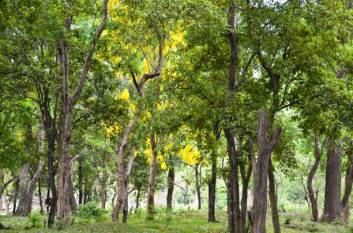HYDERABAD, 6 May 2024: Sandalwood, the aromatic heartwood of Santalum trees, has captivated civilizations for centuries. Its distinct fragrance and exquisite beauty have fueled a global demand, particularly for red sandalwood and white sandalwood varieties.
In India, where sandalwood has held cultural and economic significance for millennia, a renewed focus on its cultivation is offering promising opportunities for farmers. This report explores the potential benefits, challenges, and strategies for Indian farmers to tap into the lucrative world of sandalwood farming.
A Fragrant Investment: The Benefits of Sandalwood Cultivation
For farmers with a long-term vision, sandalwood cultivation presents several compelling advantages:
- High Market Value: Mature sandalwood trees, particularly red sandalwood, command premium prices. Per kilogram prices can range from Rs. 3,000 to Rs. 7,00an impressive return on a long-term investment.
- Low Maintenance: Sandalwood trees are remarkably resilient, thriving in dry climates with well-drained soil. Once established, they require minimal care, allowing for intercropping with other crops in the initial years.
- Appreciating Land Value: Sandalwood plantations significantly increase the value of farmland over time. This not only benefits long-term financial planning but also serves as potential collateral for loans.
A Geographical Dance: Where Sandalwood Flourishes
India's diverse climate allows for the cultivation of two primary sandalwood varieties, each with specific geographical preferences:
- Red Sandalwood's Southern Sojourn: Andhra Pradesh, particularly the Seshachalam Hills, is the historical heart of red sandalwood cultivation. The dry climate and rocky terrain of this region provide the ideal conditions for this prized variety.
- White Sandalwood's Wider Reach: White sandalwood thrives in a broader range of climates, with Karnataka, Tamil Nadu, and parts of Northern India offering suitable conditions. However, these regions generally have stricter regulations due to past exploitation.
Government Support: Nurturing a Fragrant Future
The Indian government, recognizing the economic potential of sandalwood, has implemented several initiatives to promote its controlled cultivation:
- Relaxed Regulations: Some states, like Andhra Pradesh, have eased restrictions, allowing farmers to cultivate sandalwood on private land with proper permits. This shift encourages responsible production and provides farmers with a legal avenue for income generation.
- Subsidy Programs: While limited, specific government schemes offer subsidies for planting sandalwood, offsetting initial costs and incentivizing sustainable practices.
The Global Market Awaits: Can Indian Farmers Take the Lead?
The global market for sandalwood is projected to reach USD 4 billion by 2027, driven by its diverse applications in luxury goods, fragrances, and traditional medicine. Here's how Indian farmers can position themselves as key players:
- Sustainable Practices: Obtaining certifications like Forest Stewardship Council (FSC) can demonstrate responsible sourcing and attract premium prices from international buyers.
- Quality Focus: Strict adherence to quality control measures ensures a consistent and high-grade product, maximizing export potential.
- Value Addition: Exploring avenues like essential oil extraction or crafting sandalwood-based products can create a diversified revenue stream and higher profit margins.
Challenges and Considerations: A Fragile Balance
Despite its alluring potential, sandalwood farming comes with significant challenges:
- Long Gestation Period: Patience is a crucial aspect of sandalwood cultivation. Maturation times for red sandalwood can reach 15 years, requiring alternative income sources during the interim.
- Stringent Regulations: Navigating the complex web of permits and regulations can be a hurdle, particularly for first-time farmers.
- Theft and Smuggling: The high value of sandalwood attracts illegal activities. Implementing robust security measures is essential to protect plantations.
Sandalwood farming presents a unique opportunity for Indian agriculture, offering the potential for high returns while promoting environmental sustainability. However, success hinges on a measured approach that incorporates long-term planning, adherence to regulations, and a commitment to responsible practices.
By leveraging government support, focusing on quality, and exploring value addition, Indian farmers have the potential to become key players in the global sandalwood market, ensuring a fragrant future for themselves and the nation.
Credit: DLucas/istockphoto




















